DESIGN PRACTICE I
DESIGN PRACTICE I
Week 1
Week 2
Week 4
Week 5
Week 1
introduction
I am a Game Designer focusing mainly on game Level and Mechanic designs serving the levels. I’m interested in using level design to help create Environmental storytelling, Engaging combat experience and smooth gameplay.
Game levels are an integral part of a game, level is the playable area marked by boundaries that differentiate the playable area from the non-playable area. Everything a player can control, interact with, walk around, and the enemies against the player will only appear inside the playable area. The level is the stage of the game, stage needs to be set up first, and then the actors can stand on it and start acting on top of it.
I am a Game Designer focusing mainly on game Level and Mechanic designs serving the levels. I’m interested in using level design to help create Environmental storytelling, Engaging combat experience and smooth gameplay.
Game levels are an integral part of a game, level is the playable area marked by boundaries that differentiate the playable area from the non-playable area. Everything a player can control, interact with, walk around, and the enemies against the player will only appear inside the playable area. The level is the stage of the game, stage needs to be set up first, and then the actors can stand on it and start acting on top of it.
My design progress with level design is to diverge the possible elements of that game level. Pick a few keywords using those words to build a level.
By researching, I want to figure out how to use the game level or the environments set up inside the game level to help communicate with the player. By simply using the environment and the objects or other details, passing through the story, contexts, and even the motions and perceptions to the player without telling by the voice-over or other clear notifications.
Secondly, the combat area with strategies could help create an engaging combat experience for the player. I need to find out what design patterns are available for me to study or use and how I can use level design to help create the combat area with strategies.
Thirdly, how can I “subtle” guide the player? What elements inside the level are the key elements for the hint to the player? What’s the relationship between the level and the player? Is lighting more critical for it? Or is the visual signal, or is it more relative to the architectural side?
5 keywords
Surreal Nomadic Mellifluent Foreshadow Mercurial
Surreal
Definition: Things that are surreal combine unrelated elements to create a bizarre scene. The adjective surreal comes from Surrealism, a movement that produced films, writing, painting, and other art forms that often contained irrational, disjointed images. So, surreal describes something that’s a bizarre mix of elements, often jarring and seemingly nonsensical.
Synonyms: mobile, peregrine, roving, wandering,unsettled
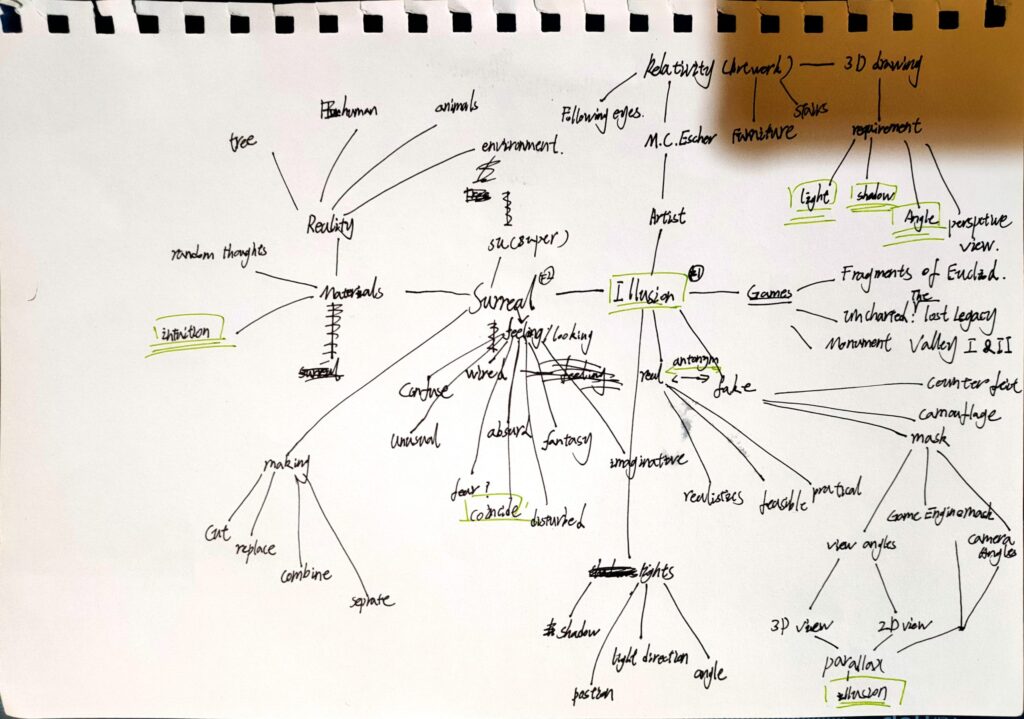
Nomaidc
Definition: A nomad is someone who lives by traveling from place to place. Nomadic thus means anything that involves moving around a lot.
Synonyms: mobile, peregrine, roving, wandering,unsettled
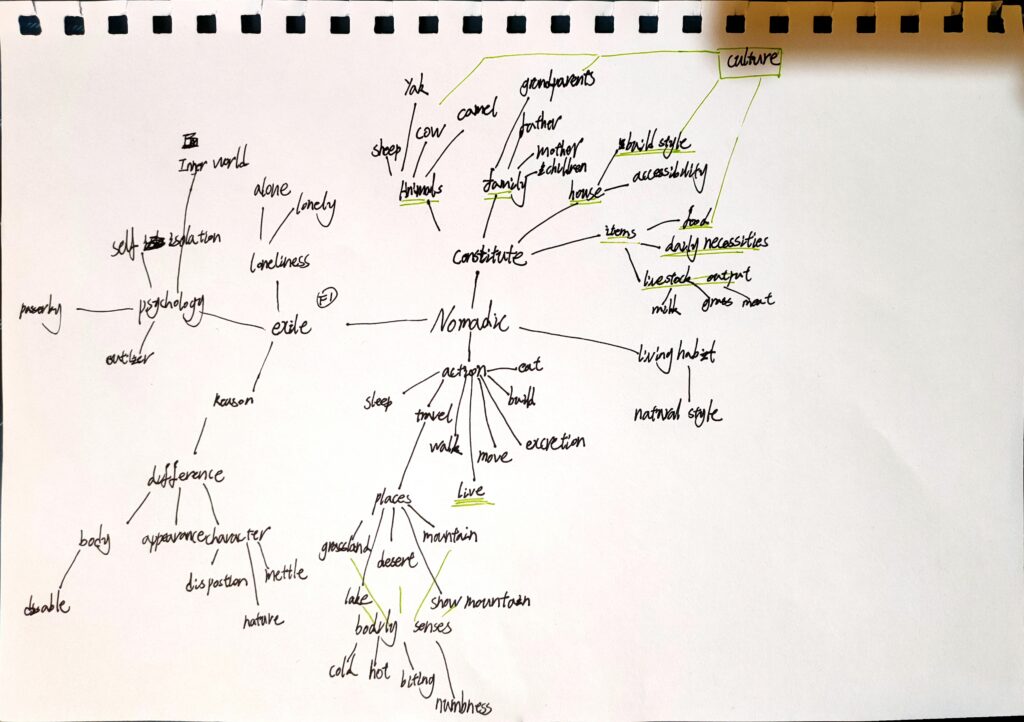
Mellifluent
Definition: Sweetly or smoothly flowing; sweet-sounding: a mellifluous voice; mellifluous tones. Flowing with honey; sweetened with or as if with honey.
Synonyms: mellifluous, mellifluously, mellifluousness
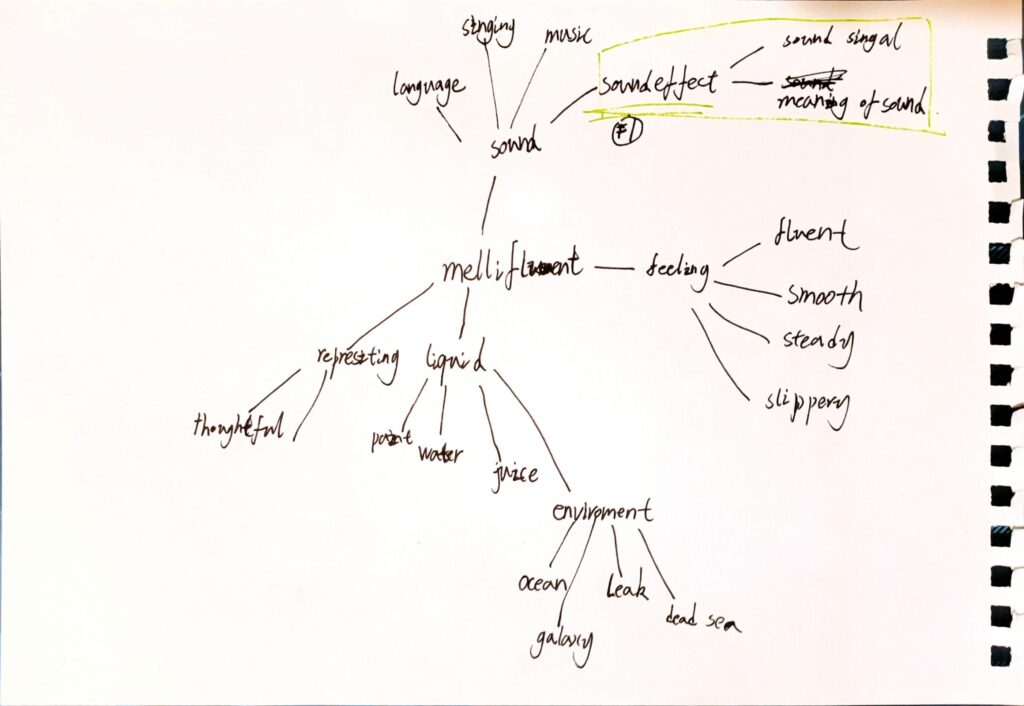
foreshadow
Definition: To foreshadow is to predict something or to give a hint of what is to come.
Synonyms: augur, auspicate, betoken, bode, forecast, foretell, omen, portend, predict, prefigure, presage, prognosticate
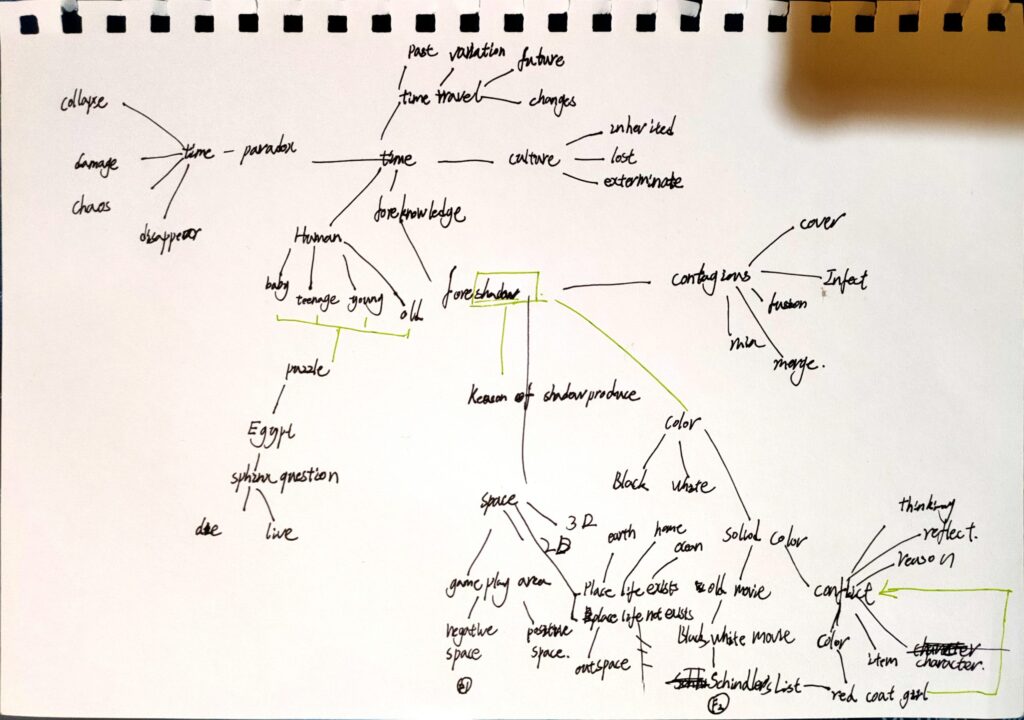
Mercurial
Definition: Mercurial describes someone whose mood or behavior is changeable and unpredictable, or someone who is clever, lively, and quick. Mercury was the ancient Roman god of commerce and messenger of the gods, and the planet Mercury was named after the Roman god. In Middle English, this adjective meant “relating to the planet or god Mercury” and derives from Latin mercuriālis, from Mercurius “Mercury.” A mercurial personality has the unpredictability associated with the god Mercury or, in astrology, is supposedly influenced by the planet
Synonyms: erratic, fickle, quicksilver, changeable, changeful
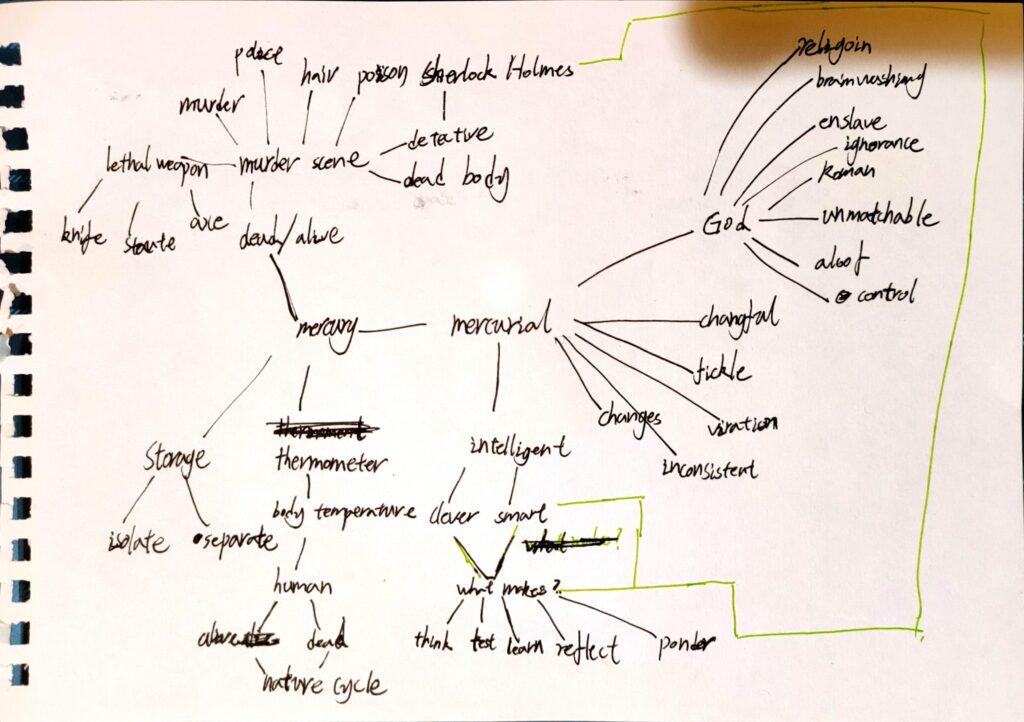
Week 2

Surreal: illusion-angles-dream like-uncanny- coincidence
Mellifluent: sound –representing – sound signal – meaning of sound
Mercurial: changeful – intelligent – thinking – critical
Nomadic: self isolation – lonely – psychology -difference – culture
Foreshadow: shadow – colors -solid color – metaphor
New connection and words after word matrix
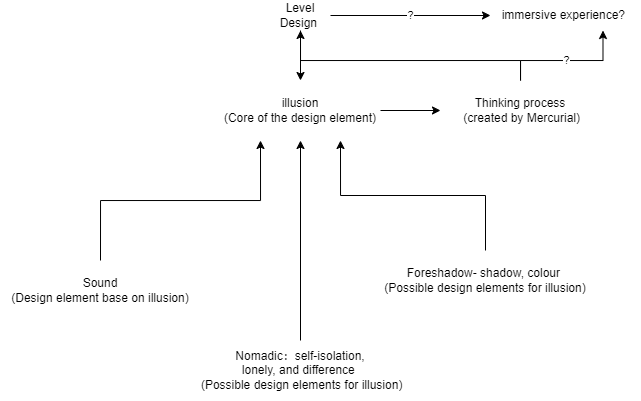
Reseach question new : How can illusions be used as a primary design element in-game levels to promote player reflection(thinking) and create an immersive experience?
Furthermore, I aim to explore the creation of illusions through 3D form and determine the range of illusions that can be generated. The expansion of words such as self-isolation, loneliness, difference, shadow, and colour will also help me focus my research and limit the design area.
Research:
Games that build the game level using the illusion or the game puzzles.
Monument Valley (2014)
https://en.wikipedia.org/wiki/Monument_Valley_(video_game)
Gameplay: https://www.youtube.com/watch?v=z2ag-RKPUcU
Monument uses ‘illusion’ ingeniously to break
the road that player must go through. The game creates many interesting puzzles
based on the simple visual ‘illusion’.
E.g.1

(light grey corner is the Illusion part for this level)
E.g.2.

Moncage (2021)
Gameplay: https://www.youtube.com/watch?v=h6YSa433O_Y
A game the player must go to a specific angle or direction to be able to solve the puzzles.
E.g. 1.

Fragments of Euclid (2016)
Game website: https://nusan.itch.io/fragments-of-euclid
Gameplay: https://www.youtube.com/watch?v=z-Kjl2yFH4U
A Puzzle game heavily influenced by M.C.Escher’s artwork ‘Relativity’. This game is just the 3D game version ‘Relativity’ filled with puzzles. The player needs to use doors to travel between different dimensions when solving the puzzles.
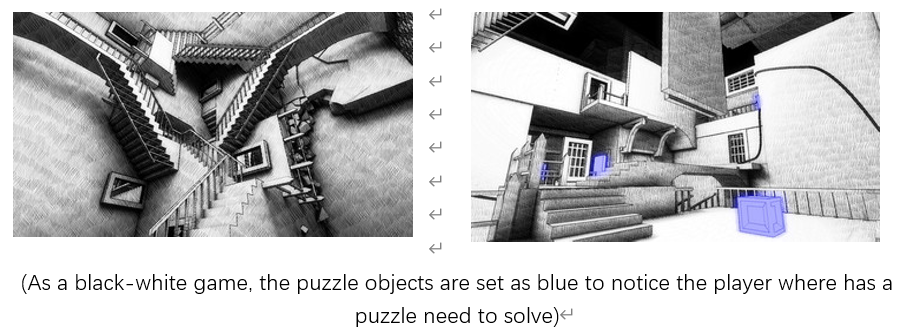
3D drawings
2d drawings but feels like 3d objects. (illusion)

Exploration 1: Penrose Tringale recreate and game play potential explore.
Recreate the Penrose triangle in Unreal Engine using a basic shape cube (Game making Engine).


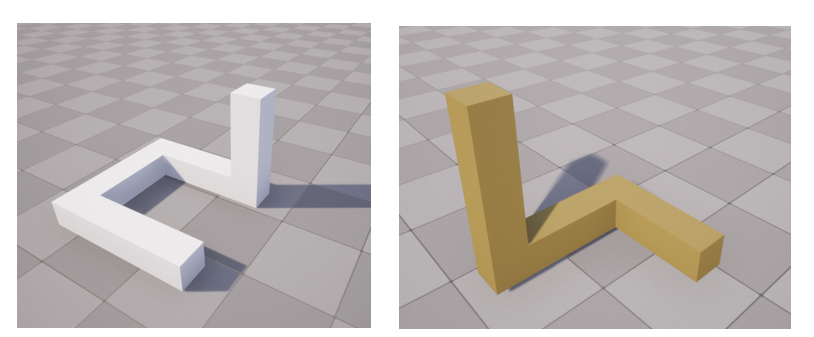
Recreate the Penrose triangle in Unreal Engine using a basic shape cube (Game making Engine).
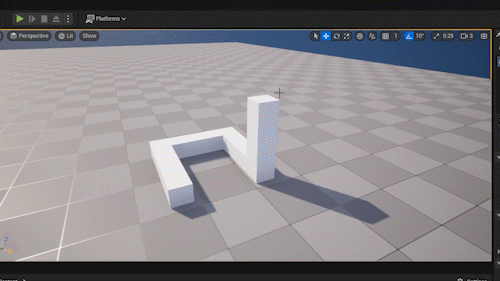
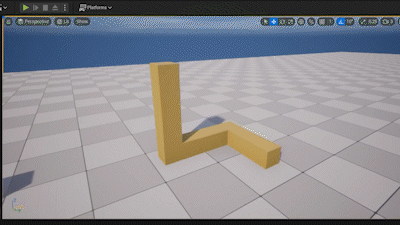
After completing the recreation of the Penrose Triangle, I conducted a simple illusion test in the game engine. The Penrose Triangle creates the illusion of an infinite loop by finding the correct angle to connect the start and end of the model. This process of creating illusions inspired me to think deeply, and I associated the keyword “mercurial” with “thinking,” because finding the correct angle requires players to use their critical thinking skills to test and experiment. I believe that this thinking process can be harnessed to create engaging and challenging gameplay experiences.
Week 3
Exploration 2: deep test and desogn on penrose Tringale
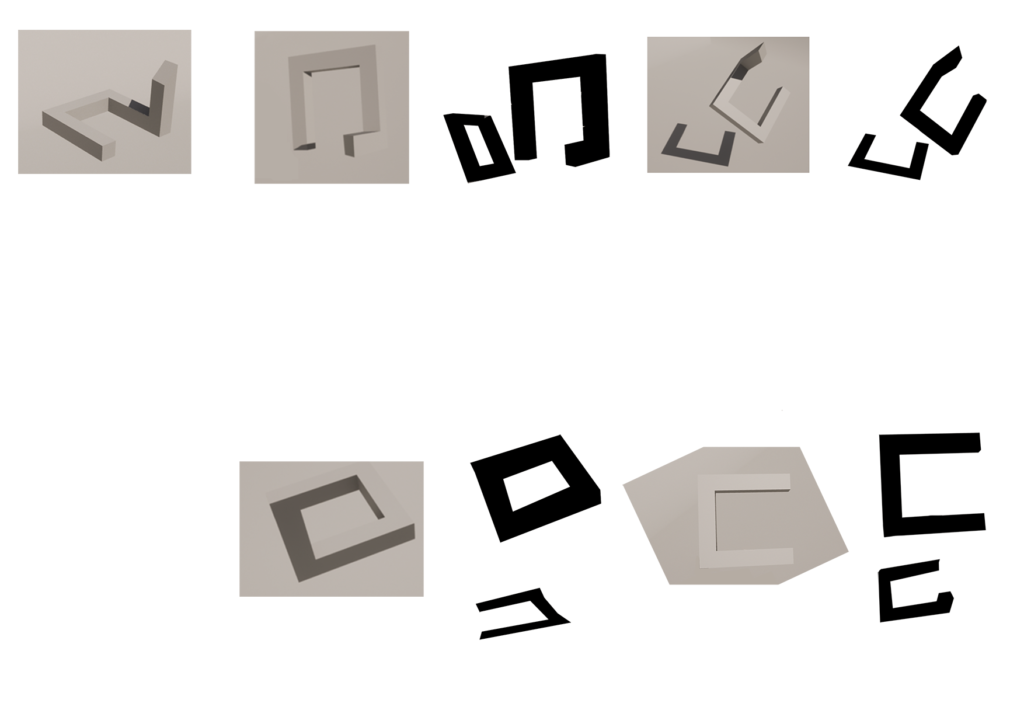
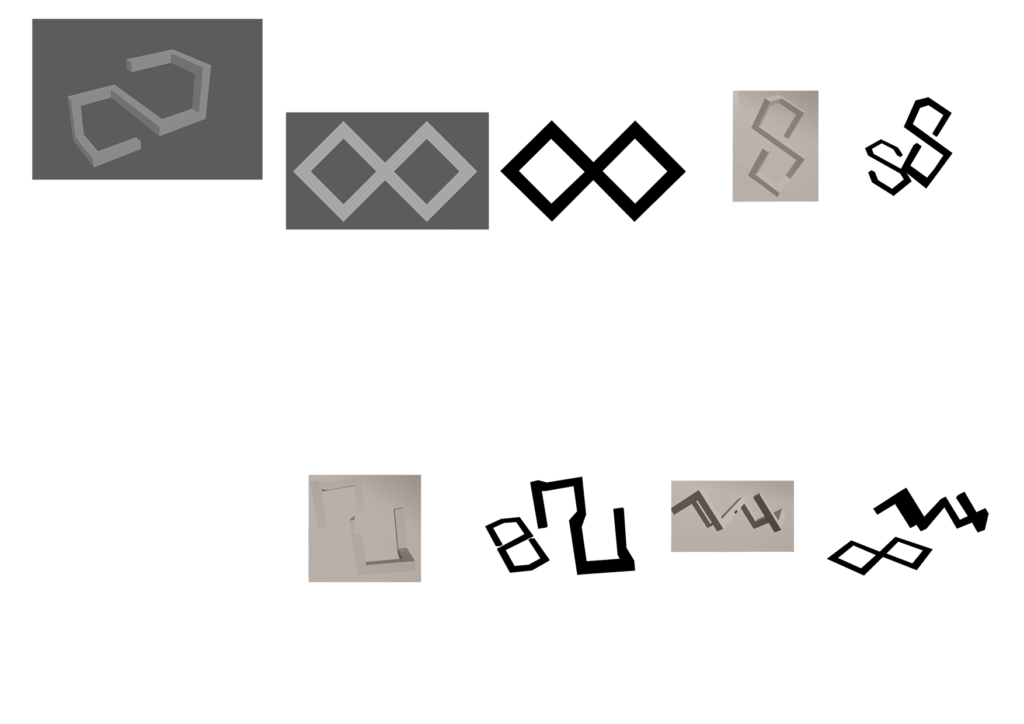

Involving the word shadow. – Using the shape of the shadow created by lighting on the model, creates shadow illusions. Shadows are pure in colour and their shapes are not affected by light or colour. By projecting shadows, I can overcome issues with lighting and produce a greater variety of shapes compared to directly observing the model.
Exploration 3: Testing of sound definition and possible illusionary elements within it.
Environment sound (answer at the end )
Item and ActionSound (answer at the end )
a sound in progress (answer at the end )
1. Ocean 2. Slient mountain 3. scrathing a tetile object 4. knocking on wood 5. Fire(burning )
For this experiment, I prepared sounds using different materials based on my own perception of sound production. Without providing any visual information, I tested random people to see if they could identify the material producing the sound based solely on the information contained within the sound. And under what circumstances most people do not know how to define material that produce sound.
For the second environmental sound , most people have difficulty identifying its exact location(material). Although they recognize it as a windy environment, they cannot accurately determine its specific characteristics. This is because the sound information is deliberately created to be ambiguous and obscure, thus hindering the identification of the material information. However, this is precisely the technique needed to create sound illusions. By using sound effects that are difficult to identify and recognize, the illusionary effect can be achieved.
Week 4
Exploring the nexus of your ideas
Feedback from peer:
Criteria 1 :
5 key words were stated, new words were found from surreal to curiosity. Explored and documented the map of word exploration from surreal to illusion it felt that there had been a lot of reflection on the words and how they connected to your interest in game design.
Feedback from lecture:
Perhaps you could map the components of a game Level and brainstorm aspects you want to consider or look into in relation to subtle guides and cues. I imagine
there are already many examples and research around this – this could help you position yourself in terms of the elements that are important to you and why. If you
are specifically thinking about colour blindness it would be good to research into this also, and perhaps see how this is addressed in other areas such as printed
materials. Re sound, you could look into audio stories and the subtle cues that are used in this space etc.
In this paper it is fine to present protoypes or work in progress in week 6 – don’t feel you need to develop a game or have all the components coming together.
We’ve had game designers in the past present physical work rather than digital as a way of extending their thinking before translating that into a game. Or perhaps
you could choose a couple of elements and choose how to represent that through a range of senses – e.g. if the level is getting hot what does that look like, sound
like, etc.
An in-depth conversation with yourself:
Personal refelct
Me personally very confused about this DP1 subject. As a game designer, I usually have a clear theme and know what I need to do without needing too much testing. Instead, I follow the specific design process of game design to estimate a theme and possible final project in advance, make a plan and then start production. And I haven’t fully determined my final research question for six months from now. I am also in a period of confusion. During weeks two to three, I was completely lost and didn’t know what to do with these keywords. After talking with Sue in the third week, I decided not to think about their connection to my final research question for now. Instead, I explored and expanded on these keywords as a game designer.
Because of my own confusion, my progress is pretty slow. Therefore, I only have two basic practical sound definition tests and 3D model illusion tests. Fortunately, after the keyword matrix and basic testing, I narrowed down the keywords for my research and practice area to sound and illusions.
Next, I will continue to add tests such as using flat textures in game engines to create scenes with depth and height. Additionally, I plan to deeply explore sound design and consider how to help colour-blind individuals recognize colours. I will research materials that have helped colour-blind individuals in the past, such as printed materials, to see what they did to colours and how to use sound to represent those method.
I’m trying to create a fantasy feeling, while exploring whether this method could help colour-blind people recognize colours they cannot feel. In terms of illusions, the focus is on studying how illusions are generated and how to apply them on objects.
I am still in the exploration and experimentation stage. In the last two weeks, I plan to enter the refinement stage, which involves thinking about how these tested elements can be applied to game design or actual objects. I will consider how they can be implemented in a game. Due to time constraints, it is unlikely that I will create a complete game, so instead I plan to use these design elements to create different 3D scenes. However, I cannot confirm whether or not audiences will be able to move around within them.
Jyoti gave me some good advice: ‘you could choose a couple of elements and choose how to represent that through a range of senses – e.g. if the level is getting hot what does that look like, sound like, etc.’ I don’t have to worry about applying it to the game; I can use 3D animation or 2D low frame rate hand-drawn animation to express this process. This process can be presented using only black and white colours, mainly sound and other visual effects.
The thought process about the meaning of sound also gave me a sudden inspiration. Instead of removing the visibility of objects, events, and environments, why don’t I create some physical models to represent those highly symbolic sounds? For example, I can make 3D models of waves and 3D print them, allowing people to associate them with the sound they produce. If time is limited, pictures can be used instead of models.
As for the aspect of illusions, like before, I still need to create more items with illusions on my own. This is necessary to explore this important element of illusion. Based on the presentation I made, I may also use 3D printing to create models with this illusion element.
Exploration 4: More Test about illusion
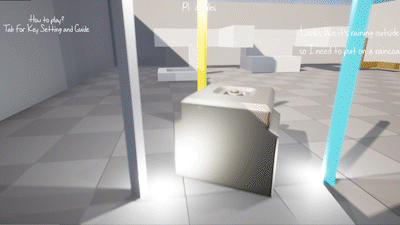
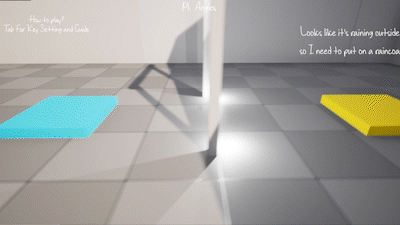
Produce more puzzles with the theme of illusions as the design focus. Unlike previous models that created illusions, this time‘s impossible geometry, changes object inside the door at different angles, using program operation instead of physical models. In this door area, items will be displayed or hidden based on the player’s camera position.
Week 5
Exploration 5: A work that combines all 5 words
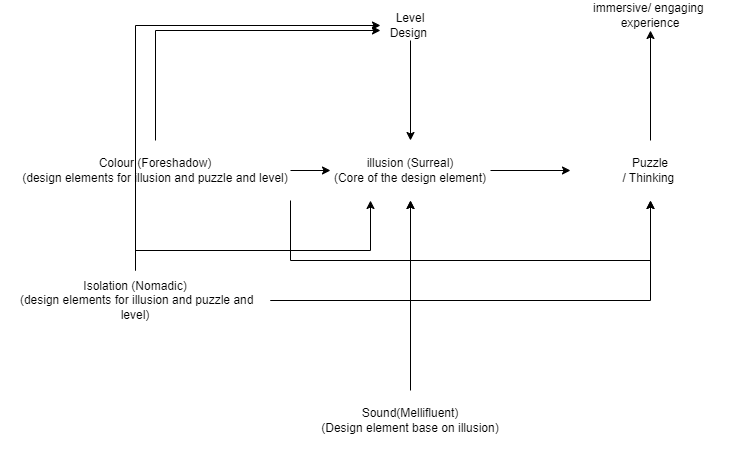
Updated words connection with the aims
Sound Illusion

Level top-down view

The place of where ‘Rain’ come from
The bacon sizilling sound use to fake the ‘Rain’
The feedback I received regarding the sound aspect made a significant impact on me. One particular example that stood out was the suggestion to choose specific elements and represent them through a range of senses, such as how to depict the level getting hot through sound and visuals. This inspired me to be more creative in my approach and to further explore the use of sound in my project. As a result, I began to incorporate the element of “contrast” into my sound design, combining it with the insights gained from the week 3 sound test and the theme of “isolation.”
Created the ‘rain’ in the level.
The initial rain sound at the beginning of the game is used to establish an audio atmosphere and create a sense of immersion for the players. This sound sets an expectation in their minds that it is raining, and it is reinforced by the textual prompts throughout the game. However, players are unable to physically interact with this element of rain, and it remains solely an auditory experience.
The contrast created by the sound of rain and the absence of actual rainfall outside leads players to question the reality of the situation and prompts them to revaluate their assumptions. This contrast serves as a catalyst for players to think more deeply about the game’s narrative and the themes it explores, ultimately leading to a more immersive and thought-provoking experience.
The twist at the end of the level, revealing that what was thought to be ‘rain’ was actually the sizzling sound of bacon, creates a strong sense of contrast for players and enhances the immersive experience. This twist is a result of the level design that aims to answer research questions.
Puzzle

Puzzle 1
Puzzle 2
The decryption interactive mechanism in the game has been updated to a puzzle-based system. Players are required to find the correct angle within a fixed area to reassemble scattered pictures. This process of finding the correct position encourages players to engage in the thinking process, resulting in a more immersive experience. However, placing these puzzles in the scene can be challenging, as misplacement often occurs, requiring repeated attempts to ensure consistency in the results.
In order to create a more immersive experience for the level, I applied the narrative structure KISHOTENKETSU6 commonly used in ancient Chinese and Japanese poetry as my design concept. The entire level is designed with an introduction, development, twist, and conclusion structure. This design can create a smoother learning curve for players by gradually increasing the difficulty of puzzle-solving in accordance with the sequence of introduction and development. Puzzle 1 has two blocks while Puzzle 2 has three blocks. The rain illusion is also based on this structure.
Playable game demo “Thougth” Full Work through:
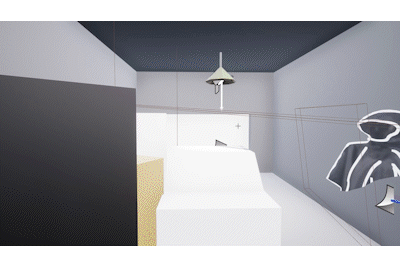
“Thougth” game play video(Tunr on the sound to watch) :